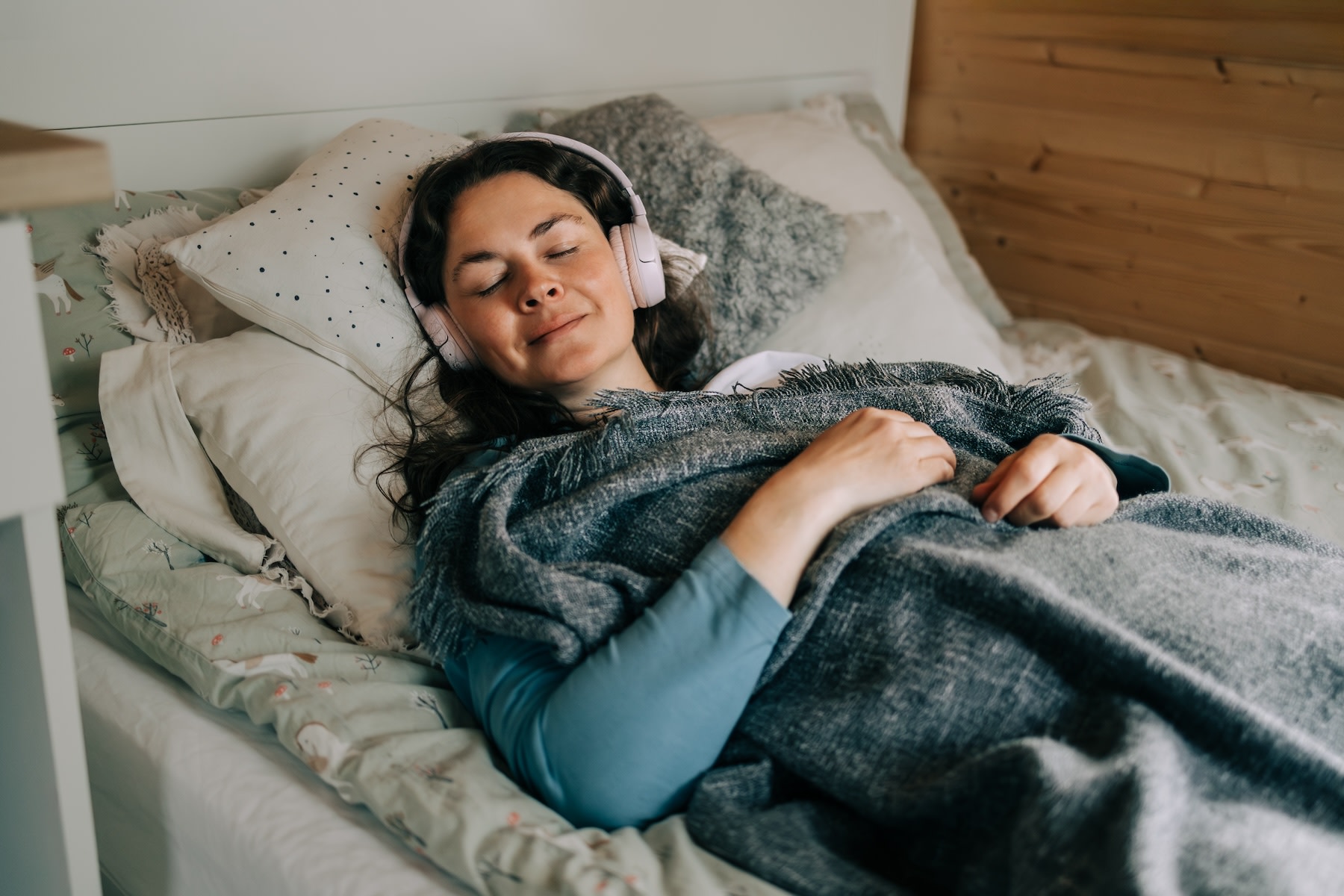
Olga Pankova / Moment via Getty Images
Yes, You Can Totally Meditate In Bed. Here’s How
Your bed just got even better.
By Michele Ross•
Can You Meditate Lying Down In Bed?
Benefits of Meditating In Bed
How to Meditate In Bed for Relaxation
How to Meditate In Bed In the Morning
How to Meditate In Bed for Sleep
Are There Any Drawbacks of Mediating In Bed?
Are Certain Types of Meditation Better Than Others When Lying Down?
The Takeaway
When you think of meditation, you might imagine an upright, blissed-out practitioner sitting still for hours on end. This picture-perfect idea can feel inaccessible for many of us, and might even be intimidating enough to dissuade you from picking up or continuing the practice. Fortunately, you don’t need to be serene and statuesque to meditate—or even stay seated, for that matter. In fact, lying down while meditating in bed is perfectly fine and even optimal for certain types of meditation.
Below, you’ll learn how to meditate in bed and discover how meditating while lying down can be beneficial for your mind, sleep, and general wellbeing.
Can You Meditate Lying Down In Bed?
It’s absolutely fine to meditate while lying down, says Peloton instructor Kirra Michel. While the standard upright, cross-legged lotus meditation position (or another seated variation) can help you stay grounded and focused, it’s not necessarily the superior pose.
“The mind does tend to be more alert and active when we are in an upright position,” Kirra explains. “That’s one of the reasons meditation is usually taught in a seated position.” But sitting up certainly isn’t a hard and fast rule. It's also not the only posture to provide all of meditation’s benefits.
“Meditation is not limited to any one posture,” Kirra clarifies. “You can still meditate lying down, and even while walking.” Many yoga classes even end with Savasana, aka Corpse Pose, in which you lie down to rest, recover, and reap the full mind-body benefits of your physical practice.
Long story short? It’s absolutely OK to meditate while lying down or in bed—and there are even some benefits that come along with it.
Benefits of Meditating In Bed
Meditating in bed is beneficial for many reasons:
It’s accessible. Meditating while lying down is accessible for everyone, from complete novices to meditation masters. For some, meditating in bed may also feel more approachable than getting set up in an upright position, making it easier to get started.
It mitigates physical discomfort. Meditating in bed is especially attractive for those who build up pain or tension in the body (like the neck, back, or hips) while sitting for long or even short periods of time. If the thought of staying still and seated is enough to keep you away from meditating at all, know that reclining in a supine position—yes, even in bed—is totally fair game.
It can help you focus on meditation. “If you are in physical pain while meditating, it’ll be hard to allow your mind to focus on anything but the pain,” Kirra says. “Lying down in a comfortable, sustainable position will help [you] relax and focus, allowing you to potentially get deeper into your meditation.”
It can help you start or end your day on a calm and mindful note. Naturally, it makes sense to meditate in bed when you’re already lying down—that is, upon waking up or going to sleep. Morning meditations offer a fresh, mood-boosting start to your day, while sleep meditations can help your mind and body unwind from the day and promote a better night’s rest.
It allows you to stay consistent with your meditation practice. Meditating in bed on the tail ends of your day can help you keep up your practice without a second thought. Instead of feeling pressure to carve out time in your schedule for a sit, meditating when you’re already free from distractions in a calm and quiet zone—both physically and mentally—is a simple way to practice daily.
How to Meditate In Bed for Relaxation
To meditate in bed for the purpose of relaxing, Kirra suggests:
Lying on your back with feet about hips’ distance apart, placing your hands a few inches away from your body with palms facing up.
Making sure your body is supported in a way that feels sustainable and comfortable. “If you need a pillow under your head or neck, [use] it,” she advises.
You can also reach for other props as needed. “If your back feels any pain when lying down with legs extended, try putting a pillow, a bolster, or blocks under your knees or calves.”
How to Meditate In Bed In the Morning
Relaxation aside, you may choose to meditate upon waking up to start the day in a mindful, calm manner before downing your first cup of coffee or tackling your daily tasks. If this sounds up your alley, therapist and meditation instructor Elizabeth Winkler offers a few suggestions for how to meditate in bed in the morning:
“Gently open the windows or shades to invite natural sunlight and a breeze,” she advises, “which will help to cue your body into wakeful presence.”
Begin with a few slow and controlled deep breaths and/or a moment of gratitude. According to Winkler, these are simple ways to set a positive tone and mindset for the day.
Worried about falling back asleep? Winkler says you can still meditate in bed, but aim to sit up with your back against the headboard instead of lying down. “Over time, you may find you can stay fully aware even while lying down,” she says. “Bedtime or morning, it becomes less about the posture and more about how we greet the moment."
Unless you’re meditating in bed at night with the specific intention to fall asleep (more on that below), do what you can to avoid drifting off.
Of course, you can always meditate on your own, but many people find it helpful to listen to guided meditations, such as those available on the Peloton App. For non-sleep meditations, instructors will helpfully cue when it’s time to open your eyes and resume your day, providing the built-in benefit of preventing unintentional snoozing.

Peloton App
Access thousands of classes with no equipment needed.
How to Meditate In Bed for Sleep
Meditating in bed with the goal of falling asleep may entail slightly different protocols from the ones shared above. “Some meditations help give us energy, [while] others help us cultivate certain qualities such as kindness or empathy—but sleep meditations are geared toward truly calming the body down, quieting the mind, and setting the stage for sleep,” as Peloton instructor Kristin McGee previously shared with The Output. Guided sleep meditations may also have hazier tones, music to activate the parasympathetic nervous system (aka the nerves that help you relax), or specific cues to help lull yourself to sleep.
To meditate in bed for better sleep, stick to the following snooze-friendly standards:
Tuck yourself in under your bedding before starting your sleep meditation. “A weighted blanket can be incredibly grounding, helping the nervous system shift into deeper rest,” Winkler adds.
Lie down in your preferred sleeping position.
Listen to a guided meditation via your phone or speakers, rather than headphones, to avoid discomfort.
When meditating in bed before sleep, it’s not just OK but encouraged to drift off into dreamland before a guided meditation ends. In fact, Winkler believes that’s a sign of success: “These practices are meant to support, not fight, your body’s natural rhythms,” she says.
Another pro tip: Staying active during the day may also complement a sleep-focused meditation practice, as exercise and meditation can be the perfect pairing for better sleep. According to a 2020 randomized control trial in the journal Sleep Health, healthy adults new to exercising or meditation experienced significant, lasting improvements in sleep quality within eight weeks of starting either practice. (Just imagine the one-two punch from including both in your wellness regimen.)
Are There Any Drawbacks of Mediating In Bed?
As beneficial as meditating in bed can be, it won’t be the right fit for all people and purposes. For starters, meditating while lying down runs the risk of dozing off. Of course, this is great for sleep meditations but less ideal for other contexts, like when meditating to boost focus or start your day on a calm note.
“In general, an upright seated position—with as much support as you need to feel comfortable—is the best position to tune in and be fully awake and present while you meditate,” says Peloton instructor Anna Greenberg. However, she echoes Winkler’s earlier sentiments about sitting up in bed for morning meditations: “A nice, seated meditation in bed supported by pillows in a calm environment is a fantastic way to start the day,” Anna says.
Still, if sitting upright creates physical discomfort or another barrier that dissuades you from meditating in other contexts, remember that meditating in bed is better than not meditating at all.
Are Certain Types of Meditation Better Than Others When Lying Down?
According to Anna, it’s best to save lying down for sleep meditations or those geared for deep relaxation.
While Kirra says that most meditations can be practiced in bed, calming and deeper styles—such as body scans or, of course, sleep meditations—are the best fits. In addition, she cites yoga nidra, an ancient tantric technique with the ultimate goal being complete relaxation, as another practice that’s best practiced while lying down.
These types of meditation are ideal for lying down since their goals include releasing and relaxing—rather than focusing or contemplating—and a prone position can help facilitate a sense of tranquility.
The Takeaway
For those who find seated meditations intimidating, fussy, or uncomfortable, meditating in bed is a surefire way to reap the rewards of the mindfulness practice with ease. Whether you choose to tune into a guided meditation upon rising, for a midday reset, or as a soothing pre-sleep ritual, rest assured that meditating while lying down is neither wrong nor ill-advised. So lie back, relax, and allow yourself to meditate on your own terms—and even better, in the comfort of your own bed.
This content is for informational and educational purposes only and does not constitute individualized advice. It is not intended to replace professional medical evaluation, diagnosis, or treatment. Seek the advice of your physician for questions you may have regarding your health or a medical condition. If you are having a medical emergency, call your physician or 911 immediately.
Level up your inbox.
Subscribe for a weekly dose of fitness, plus the latest promos, launches, and events.
By providing your email address, you agree to receive marketing communications from Peloton.
For more about how we use your information, see our Privacy Policy.












